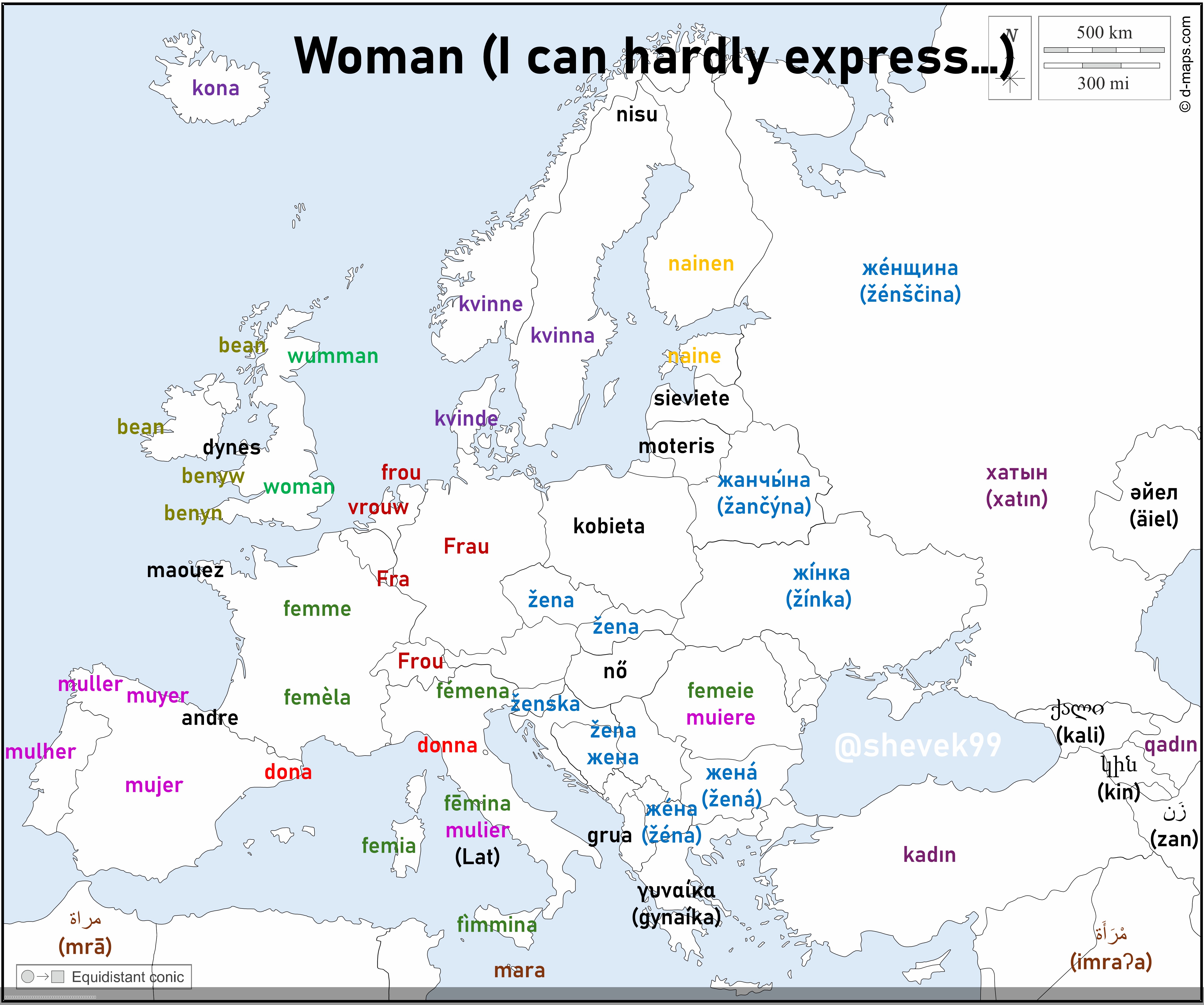Map of the Word 'Woman' in Different Languages


Alex Cartwright
Senior Cartographer & GIS Specialist
Alex Cartwright is a renowned cartographer and geographic information systems specialist with over 15 years of experience in spatial analysis and data...
Geographic Analysis
What This Map Shows
The visualization titled "Woman in Different Languages v.2.0" provides a captivating glimpse into the linguistic diversity across the globe, specifically focusing on how the term 'woman' is expressed in various languages. This map is not just a simple representation of words; it reflects the cultural nuances, historical contexts, and regional identities embedded within each language. By including languages such as Cornish, Tatar, and Swiss German, the map offers an expanded perspective on how femininity is articulated worldwide.
Deep Dive into Linguistic Diversity
Language is an integral part of human culture and identity. Each term carries with it a wealth of cultural significance and societal norms. The term 'woman' is no exception; it reflects not just a biological designation but also role expectations, historical context, and the evolution of gender perceptions in various societies.
Interestingly, many languages share roots that influence their structure and vocabulary. For example, in Indo-European languages, the term for 'woman' often relates to words that signify respect or status. The English 'woman' derives from the Old English 'wīfman', with 'wīf' meaning wife and 'man' referring to a human being. This etymology hints at historical views where women's identities were closely tied to marriage and family roles.
On the other hand, in languages such as Tatar, the word for 'woman' is 'хатын' (khatyn), which also reflects societal structures and values unique to Tatar culture. The Tatar language itself is part of the Turkic language family, showcasing the rich tapestry of linguistic heritage across Eurasia.
The addition of Cornish, a Celtic language that has seen a revival in recent years, introduces another layer of complexity. The word for 'woman' in Cornish is 'benyn', and this term is deeply rooted in the local history and traditions of Cornwall, highlighting how language can be a vessel for cultural preservation.
What's fascinating is how Swiss German, a dialect spoken in Switzerland, uses 'Frau' to signify 'woman'. The Swiss German dialects are characterized by a variety of local influences and reflect the multilingual nature of the country, where German, French, and Italian coexist.
Understanding these variations in terminology is crucial as it provides insights into gender roles and societal structures across cultures. The linguistic diversity represented in the map is a reminder of the richness of human expression and the varying perceptions of gender throughout history.
Regional Analysis
When analyzing the regional aspects of the term 'woman', we see distinct patterns emerge. For instance, in Europe, languages such as French ('femme'), Spanish ('mujer'), and Italian ('donna') all stem from Latin, reflecting the shared cultural heritage of Romance languages. However, their usage and the cultural context surrounding femininity can differ greatly. In many cases, the term 'woman' is associated with strong societal roles, particularly in Mediterranean cultures where matriarchal influences are prominent.
Conversely, in regions where patriarchal structures are more prevalent, such as parts of South Asia and the Middle East, the term may carry more weight in terms of societal roles and expectations. For example, in Arabic, 'امرأة' (imra'a) not only denotes a woman but also encompasses societal roles that are often tied to family and community responsibilities.
In Africa, the diversity of languages such as Swahili ('mwanamke') and Zulu ('umfazi') reflects the continent's rich linguistic heritage. Each term encapsulates unique cultural meanings, illustrating how gender roles and identities are shaped by local customs and traditions.
Significance and Impact
Understanding how the term 'woman' is expressed across different languages is significant for several reasons. Firstly, it allows us to appreciate the rich tapestry of cultural identities that exist around the world. Language is not just a tool for communication; it is a reflection of societal values, norms, and history.
Moreover, as discussions around gender equality and women's rights continue to evolve, recognizing the linguistic diversity associated with femininity can enhance our understanding of global issues. It allows for a more nuanced approach to advocacy and policy-making, as cultural contexts greatly influence perceptions of gender.
Looking towards the future, the revival of languages like Cornish shows a growing interest in cultural preservation and identity. As societies continue to grapple with the implications of gender roles, understanding the linguistic landscape will be crucial for fostering inclusivity and equality. The map serves as a reminder that language is dynamic and that the words we use can shape our understanding of gender and identity.
In conclusion, the visualization of the term 'woman' across various languages is not merely a linguistic exercise; it is a gateway into understanding the cultural, historical, and social contexts that define femininity worldwide. By recognizing and celebrating this diversity, we can work towards a more inclusive future.
Visualization Details
- Published
- August 6, 2025
- Views
- 96
Comments
Loading comments...